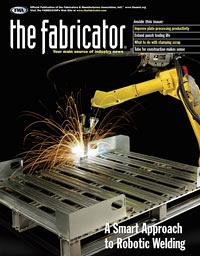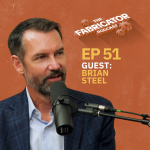Contributing Writer
- FMA
- The Fabricator
- FABTECH
- Canadian Metalworking
Categories
- Additive Manufacturing
- Aluminum Welding
- Arc Welding
- Assembly and Joining
- Automation and Robotics
- Bending and Forming
- Consumables
- Cutting and Weld Prep
- Electric Vehicles
- En Español
- Finishing
- Hydroforming
- Laser Cutting
- Laser Welding
- Machining
- Manufacturing Software
- Materials Handling
- Metals/Materials
- Oxyfuel Cutting
- Plasma Cutting
- Power Tools
- Punching and Other Holemaking
- Roll Forming
- Safety
- Sawing
- Shearing
- Shop Management
- Testing and Measuring
- Tube and Pipe Fabrication
- Tube and Pipe Production
- Waterjet Cutting
Industry Directory
Webcasts
Podcasts
FAB 40
Advertise
Subscribe
Account Login
Search
Maximizing your scrap's value
Diligence in preparation and tracking pays off
- By Greg Cozzi
- November 29, 2001
- Article
- Shop Management
 |
Scrap, an often annoying byproduct for metal fabricators, is raw material for scrap metal recyclers. Just as you closely watch the quality of your incoming raw materials, scrap recyclers watch the quality of their incoming raw materials. The more uniform and free of contaminants the scrap is that you sell to them, the more they can afford to pay you for it.
Too often, you may leave money on the table because you don't adequately track and control the scrap you're selling. You may be ignoring simple, cost-effective practices — such as knowing the grade, weight, and value of your scrap — that can increase your revenue.In selling scrap to a recycler, two principles rule:
1. Know what you're selling versus what you're getting paid for.
2. Incorporate sorting and cleaning in your production stream to reduce the sorting and cleaning costs your recycler must subtract from your price per pound.
Prepare to Sell
Prepare scrap for selling it as you produce it. Mixed and contaminated scrap sells for far less than sorted and clean scrap.The simplest form of sorting is not to mix items in the first place. Keep turnings separate from cutoffs, punchings, and sheets. Don't downgrade premium materials by mixing them with low-grade materials.
Put brass, steel, stainless, aluminum, etc., in individual containers — a drum of copper turnings in a load of steel turnings makes the whole load worthless. Also segregate alloys of the same metal; different alloys of aluminum, for example, may have the same scrap value individually, but their value decreases if they are mixed.
Segregate also by size. Slit coil stock, for example, sells for more if you cut it into its most marketable size because this increases the density of the material in the containers. In turn, handling and freight costs for you and your recycler will decrease.
Using the correct size containers (available from your recycler) at your facility will help maximize your revenue. Be sure that they are serially numbered so that you can track and audit your payment later.
Scrap loses value if it is excessively contaminated with lubricants and cutting fluids. Reclaiming fluids by draining or spinning not only increases your scrap value, but you may be able to reuse them.
When switching from one metal to another in a machine, no matter how well you clean, some old material will be caught in the machine. Therefore, keep the first container of scrap from the new run to be sold as mixed.
Downstream Environmental Liability
A new factor in scrap management is that government regulations and case law now impose liability on fabricators for safe handling of their scrap all the way to remelt in primary metals mills. The government doesn't want scrap processors hauling containers leaking fluids on the highways or dumping scrap containing free-flowing fluids in recyclers' yards.
Downstream liability can come back to haunt fabricators years, even decades, after selling scrap if that scrap has caused environmental damage; courts have held that fabricators are potentially responsible parties because contaminants in scrap they shipped to dealers contributed to the cleanup.
Because some fluid always will cling to scrap, the metal recycler's facility should be designed to process and ship your material properly.
Value of Sorting and Cleaning
What is the value to you of scrap as you create it compared to adding the processes of the scrap being sorted and cleaned?
Sorting at the machines of origin may be inexpensive, even though some new equipment and training may be involved. The cost of cutting scrap to premium sizes may be more than recovered, for example, because fewer labor-hours are needed to load and move the same weight with fewer pickups, and the unit price you receive increases.
Segregating, sorting, and cleaning scrap pay off. Your recycler can examine your operations and make specific recommendations regarding optimum container sizes and styles, crusher and spinner systems, material handling equipment, emergency services, optimum pickup schedules, and environmental practices.
Shipping and Handling
The most important step in protecting the value of your scrap is keeping track of it from the point of origin in your plant to your recycler's yard.
Too often, fabricators let shipping dock workers get rid of their scrap. If they can't or don't grade your scrap accurately, they really don't know what's in the containers, so it's likely to be downgraded, and you get minimum revenue.
A dockhand can sign for a container of aluminum and a container of steel, but container weights could be switched on the receiving end. If he doesn't know what the container weights are before they leave your dock, he may be attracted to a higher unit price. But unit price is meaningless unless you weigh your scrap before it leaves the plant.
Create an Audit Trail
An audit trail is complete documentation to authenticate the amount and sale of your scrap. To create a trail, use only serial-numbered containers, and weigh each container in your plant before it's picked up. Create a bill of lading that records the gross, tare, and net weights, along with the container serial numbers and the material actually inside the container by commodity, grade, piece sizes, and cleanliness.
The driver who picks up your containers should sign the bills of lading with a legible signature. He also should provide a pickup receipt showing his truck number, the container number(s), time and date of pickup, and the signature of someone from your plant. When the load arrives at the recycler's yard, the receiver again should weigh the load electronically and then generate a numbered scale ticket for each container showing the gross, tare, and net weights, as well as the contents, your bill of lading number, the container number picked up, and the time and date.
The recycler should send this scale ticket along with your payment check so that you can be sure that you're being paid for the actual quality and weight of your scrap. Also compare the unit prices published in the trade papers with what you're being paid.
Protect Distressed Inventory
All fabricators produce some finished goods that don't pass quality control. These products are tagged for scrapping because they have been rejected for dents, scratches, or other defects by the fabricator or its customers.
Many fabricators, thinking that the scrap recycler has destroyed their distressed inventory, have been surprised to find these products for sale in the open market. The fabricators are thus competing with themselves and may be exposed to product liability claims.
To prevent this, demand written certification that your distressed inventory indeed has been shredded or crushed. Many fabricators actually accompany their shipments of distressed inventory to the recycling yard to see for themselves that this has happened. So to get what your scrap is really worth, prepare it to maximize its value and maintain a comprehensive, disciplined audit trail, even with certificates of destruction when necessary.
About the Author
subscribe now

The Fabricator is North America's leading magazine for the metal forming and fabricating industry. The magazine delivers the news, technical articles, and case histories that enable fabricators to do their jobs more efficiently. The Fabricator has served the industry since 1970.
start your free subscription- Stay connected from anywhere

Easily access valuable industry resources now with full access to the digital edition of The Fabricator.

Easily access valuable industry resources now with full access to the digital edition of The Welder.

Easily access valuable industry resources now with full access to the digital edition of The Tube and Pipe Journal.
- Podcasting
- Podcast:
- The Fabricator Podcast
- Published:
- 04/09/2024
- Running Time:
- 63:55
In this podcast episode, Brian Steel, CEO of Cadrex Manufacturing, discusses the challenges of acquiring, merging, and integrating...
- Industry Events
16th Annual Safety Conference
- April 30 - May 1, 2024
- Elgin,
Pipe and Tube Conference
- May 21 - 22, 2024
- Omaha, NE
World-Class Roll Forming Workshop
- June 5 - 6, 2024
- Louisville, KY
Advanced Laser Application Workshop
- June 25 - 27, 2024
- Novi, MI































